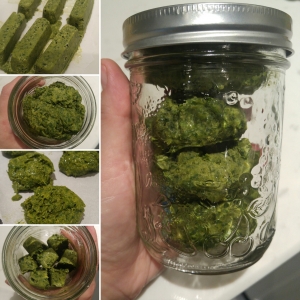This post contains affiliate links. Click here to see what that means.
Okay, so we’re cutting out dairy on the AIP, nuts and grains too … so what’s left for options when it comes to “milk” on the AIP?
Great question! I’m going to keep it plain and simple – you have 4 options during the elimination phase of the AIP: Coconut Milk, Tigernut Milk (Tigernuts are not nuts, they’re tubers), Avocado Milk and Banana Milk.
All four of these can easily be made at home, and quality additive-free coconut milk (NOT coconut “beverage”) can be found in lots of stores these days (warning – be sure your coconut milk contains nothing but coconut and water – no other ingredients, emulsifiers or thickeners like guar gum, locust bean gum, etc. You can find additive-free coconut milk using my shopping resources – click here, and some brand recommendations here.)
While there are variations of these recipes available online, the following are the basics.Coconut Milk:
4 Cups Hot Water
1 1/2 to 2 Cups Unsweetened Unsulphured Shredded Coconut
Optional Sweetener: 1/2 to 1 tsp Honey or Maple Syrup to Taste or 1 unsulphured pitted date to sweeten
Optional Flavor: 1/2 tsp Organic Vanilla Extract (not flavor), 1/2 cup pureed fresh or frozen strawberries
Place hot but not boiling water and coconut in a high-speed blender. Blend on high speed for several minutes until thick and creamy.
Using a large bowl to catch the milk, pour the mixture through a nut milk bad or fine mesh sieve lined with cheesecloth and allow to strain.
Once cool enough to handle, use your hands to squeeze out as much milk as possible.
Once you have extracted all of your milk add any optional flavoring and store in the refrigerator in a glass jar for up to 3 days.
NOTE: you will want to use a wide mouth jar so you can scrape any coconut cream off the top that forms after refrigeration for use in other things, or simply shake to reincorporate
Easiest Coconut Milk:
1 Can (500ml) Additive-Free Coconut Milk (coconut and water as ingredients only)
2 Cans Filtered Water
1 tsp Maple Syrup
Pinch of Sea Salt / Himalayan Salt
1/2 tsp Quality Organic Vanilla Extract
Combine all ingredients together in a blender or use a large jug/pot with an immersion blender. If there are considerable coconut solids in the can, you may want to slightly heat the mixture on the stove – I find this helps avoid clumps. Store in the refrigerator in glass jars and shake well before using.
Avocado Milk:
2 Cups Filtered Water
1/2 Cup Diced Avocado (ensure it’s not over ripe and does not have any dark spots)
Pinch of Sea Salt
Optional Sweetener: 1/2 to 1 tsp Honey or Maple Syrup to Taste or 1 unsulphured pitted date to sweeten
Optional Flavor: 1/2 tsp Organic Vanilla Extract (not flavor)
Combine water, avocado and a pinch of salt together in a blender or use an immersion blender. If you want a slightly sweet taste, add the sweetener of choice from above, blend and test the flavor, adjust if necessary.
Serve chilled.
Note: Best consumed or used right away in a recipe
Banana Milk:
2 Cups Filtered Water
1 Banana (ripe but not over-ripe)
Pinch of Sea Salt
Optional Flavor: 1/2 tsp Organic Vanilla Extract (not flavor) or a Pinch of Cinnamon
Combine water, banana and a pinch of salt together in a blender or use an immersion blender. If you want a slightly sweet taste, add the sweetener of choice from above, blend and test the flavor, adjust if necessary.
Serve chilled.
Note: Best consumed or used right away in a recipe
Tigernut Milk:
4 Cups Hot Water (Plus more for soaking)
1 Cup Tigernuts
Optional Sweetener: 1/2 to 1 tsp Honey or Maple Syrup to Taste or 1 unsulphured pitted date to sweeten
Optional Flavor: 1/2 tsp Organic Vanilla Extract (not flavor) or Cinnamon
Place tigernuts in a bowl and cover with warm water, allowing to soak for 24 hours.
After 24 hours, drain and place in a high-speed blender. Add 1/2 a cup of the hot water and blend for 3 minutes. If the mixture is too dry during this time, add a little more of the water and scrape the sides.
Add remaining water and blend for 10-15 minutes.
Using a large bowl to catch the milk, pour the mixture through a nut milk bad or fine mesh sieve lined with cheesecloth and allow to strain.
Once cool enough to handle, use your hands to squeeze out as much milk as possible.
Once you have extracted all of your milk add any optional flavoring and store in the refrigerator in a glass container for up to 3 days.
BONUS TIP: Don’t waste the pulp! You can dehydrate it and you have tigernut flour! Simply spread the pulp on a large, rimmed baking tray and place it in a 160 to 175 degree oven for 4-6 hours or until dry. Be sure to stir it a few times during the drying process. Once it has completely dried pulse it in a food processor until it is the consistency of powder or flour. If you can’t get it completely fine, that’s not a problem – tigernut flour tends to be a little gritty. You can choose to sift it to get rid of any larger pieces.
Sweet Potato Milk:
1 Large White Sweet Potato (Learn more about various varieties of white sweet potatoes and where to find them – click here)
4 Cups of Filtered Water (plus more after cooking – see instructions)
Optional Flavor: 1/2 tsp Organic Vanilla Extract (not flavor) or Cinnamon
Add filtered water to a medium pot. Peel and chop the sweet potato into 1 inch cubes and immediately add to the pot of water.
Bring to a boil over medium heat and continue to boil for 10-15 minutes or until the sweet potatoes are soft.
Use a slotted spoon and transfer the sweet potatoes to a blender.
Pour the cooking water into a large measuring cup and add additional filtered water to equal a total of 4 cups of liquid.
Add water to the blender and blend on high speed until completely smooth and creamy.
The “milk” should be plenty sweet enough, but if you like you can add in your optional flavors now and 1/2 to 1 tsp of pure maple syrup if you wish.
Store in the refrigerator in a glass container for up to 3 days or the freezer for 3 months.
Learn More:
Want to know the ins and outs, what’s and whys of eliminating dairy and options for reintroductions when the time comes? Check out the following articles.
The Great Dairy Debate
Why I Don’t Need to Worry About Calcium
Goat Milk and the Benefits of A2 Dairy
The Best Dairy Choice for Growing Children

 The elimination stage of the AIP is NOT meant to last forever, but how do you feel about the reintroduction process? Many find the thought of it completely overwhelming and some are afraid to move beyond eliminations because they’ve seen so many improvements in their health they don’t want to risk throwing anything off. It’s really important, however, that we not get stuck .. we need to keep moving forward on our healing journeys! Thankfully, now we can move forward with confidence thanks to the help of
The elimination stage of the AIP is NOT meant to last forever, but how do you feel about the reintroduction process? Many find the thought of it completely overwhelming and some are afraid to move beyond eliminations because they’ve seen so many improvements in their health they don’t want to risk throwing anything off. It’s really important, however, that we not get stuck .. we need to keep moving forward on our healing journeys! Thankfully, now we can move forward with confidence thanks to the help of  Araza makeup follows similar guidelines to that of the Paleo Diet, meaning it’s strictly tested and certified to be free from legumes, dairy, gluten, grains and anything artificial and harmful.
Araza makeup follows similar guidelines to that of the Paleo Diet, meaning it’s strictly tested and certified to be free from legumes, dairy, gluten, grains and anything artificial and harmful.



